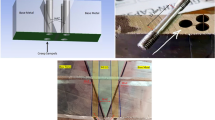Results of experimental and theoretical studies are used to extend understanding of thermal and deformation stability of untransformed austenite in the martensitic-austenitic (MA) component of low-carbon steel bainitic structure. Analysis of the effect of compressive hydrostatic stresses developing during dilatation on austenite stabilization makes it possible to obtain relationships for determining the temperature of the start of martensitic transformation in the MA-component as a function of its volume fraction in the steel structure in order to find the level of deformation due to strain-induced martensitic transformation.









Similar content being viewed by others
Notes
Here and subsequently element content (apart from specified cases) is given in weight fractions, expressed as %.
References
N. Fonstein, “Advanced high strength sheet steels,” in: Physical Metallurgy, Design, Processing, and Properties. Chapter 5: TRIP Steels, Springer International Publishing (2015).
S. Yu. Kondrat’ev, O. G. Zotov, G. Ya. Yaroslavskii, et al., “Investigation of interrelationship between damping capacity and mechanical properties as well as morphology of martensite in alloys with reversible martensite transformation,” Probl. Proch., 14B(3), 79 – 82 (1983).
G. P. Anastasiadi, S. Yu. Kondrat’ev, V. A. Malyshevskii, and M. V. Sil’nikov, “Importance of thermokinetic diagrams of transformation of supercooled austenite for development of heat treatment modes for critical steel parts,” Metal Sci. Heat Treat., 58(11), 656 – 661 (2017).
N. G. Kolbasnikov, M. S. Sakharov, S. A. Kuzin, and V. S. Teteryatnikov, “Stability of untransformed austenite in M/A-phase of low-carbon steel bainitic structure,” Metalloved. Term. Obrab. Met., No. 2, 3 – 8 (2021).
J. M. Reichert, T. Garcin, M. Militzer, andW. J. Poole, “Formation of martensite/austenite (m/a) in X80 linepipe steel,” in: Proceedings of the 2012 9th International Pipeline Conference IPC2012. September 24 – 28, 2012, Calgary, Alberta, Canada, IPC2012-90465.
T. Hara, Y. Shinohara, Y. Terada, et al., “Development of high deformable high strain line pipe, suitable for strain-based design,” in: Proceedings of Pipeline Conference Ostend., 12 – 14 October 2009, Paper No. Ostend 2009-014.
H. Sun, S. An, D. Meng, et al., “Influence of cooling conditions on microstructure and tensile properties of X80 high deformability line pipe steel,” in: Proceedings of HSLP 2010 International Seminar on Application of High Strength Line Pipe, Xi’an, China (2010).
C. Zhiquang, Ch. Quiming, et al., “Effects of thermomechanical control process on microstructure and properties of X80 grade high-strain pipe line steel,” in: Proceedings of HSLP 2010 International Seminar on Application of High Strength Line Pipe, Xi’an, China (2010).
I. Nobuyuki, E. Shingeru, and K. Joe, “High performance UOE line-pipes,” JFE Tech. Report, No. 7, Jan. (2006).
J. Y. Yoo, S. H. Chon, and D. H. Seo, “Microstructure and mechanical properties of X80 linepipe steel with high strain aging resistance,” in: Proceedings of Pipeline Conference Ostend., 12 – 14 October, 2009, Paper No. Ostend 2009-020.
X. Liang, The Complex Phase Transformation of Austenite in High Strength Linepipe Steels and Its Influence on the Mechanical Properties, Author’s Abstract of Doctoral’s Thesis, University of Pittsburgh Swanson School of Engineering (2012).
N. G. Kolbasnikov, S, A. Kuzin, V. S. Teteryatnikov, et al., “Role of bainitic structure martensite-austenite component in forming pipe steel properties. 1. Effect of TMT parameters,” Metalloved. Term. Obrab. Met., No. 2, 3 – 10 (2022).
D. F. Sokolov, A. A. Vasil’ev, N. G. Kolbasnikov, and S. F. Sokolov, “Empirical equation for calculating temperature and carbon concentration relating to para-equilibrium of main phases within steel,” Vopr. Materialoved., No. 1, 5 – 13 (2012).
D. F. Sokolov, S. F. Sokolov, A. A. Vasilev, and N. G. Kolbasnikov, Certificate for Registering a Program for AusEvol+ Computer No. 2011615304 [in Russian] (2011), register. 24 June.
A. I. Rudskoi and N. G. Kolbasnikov, “Digital twins of steel thermomechanical treatment technology,” Metalloved. Term. Obrab. Met., No. 1(775), 4 – 11 (2020).
A. I. Rudskoi, Scientific Bases of Controlling Steel Structure and Properties During Thermomechanical Treatment [in Russian], Izd. RAN, Moscow (2019).
S. S. Babu, E. D. Specht, S. A. David, et al., “In-situ observations of lattice parameter fluctuations in austenite and transformation to bainite,” Metall. Mater. Trans. A, 36A, 3281 – 3289 (2005).
N. G. Kolbasnikov, “Effect of stresses and plastic strains on the martensitic transformations,” Metal. Obrab., No. 6, 30 – 36 (2001).
N. G. Kolbasnikov and S. Yu. Kondrat’ev, Structure. Entropy. Phase Transformations and Properties of Metals [in Russian], St. Petersburg Gos. Politekh. Univ., St. Petersburg (2006).
Yu. A. Geller and A. G. Rakhstadt, Material Science (Analysis Methods, Laboratory Work, and Tasks) [in Russian], Metallurgiya, Moscow (1975).
W. Köster (Koester), “Die Temperatur abhangigkeit des Elastizitäs moduls reiner Metalle (The temperature dependence of the elasticity module of pure metals),” Z. Metallk., 39(1), 1 – 9 (1948).
Author information
Authors and Affiliations
Corresponding author
Additional information
Translated from Metallovedenie i Termicheskaya Obrabotka Metallov, No. 3, pp. 3 – 12, March, 2022.
Rights and permissions
Springer Nature or its licensor holds exclusive rights to this article under a publishing agreement with the author(s) or other rightsholder(s); author self-archiving of the accepted manuscript version of this article is solely governed by the terms of such publishing agreement and applicable law.
About this article
Cite this article
Kolbasnikov, N.G., Kuzin, S.A., Teteryatnikov, V.S. et al. Role of Bainitic Structure Martensitic-Austenitic Component in Pipe Steel Property Formation. 2. Austenite Deformation and Thermal Stability. Met Sci Heat Treat 64, 137–145 (2022). https://doi.org/10.1007/s11041-022-00774-1
Received:
Published:
Issue Date:
DOI: https://doi.org/10.1007/s11041-022-00774-1




